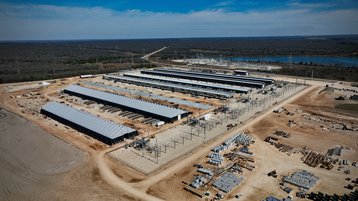Cryptoming firm Riot Blockchain made more money in July from credits given to it in exchange for powering down operations during times of high load, than it did from actually mining cryptocurrency.
In July 2022, Riot produced 318 BTC. However, it earned an estimated $9.5 million (approximately 439 BTC in July prices) in power credits as a result of curtailment activity.
“We are pleased to report that Riot has demonstrated the effectiveness of its power strategy during the month of July. The Company has consistently and proactively pursued low-cost, large-scale access to power under its long-term fixed rate power contracts, providing it with a unique ability to support ERCOT and release capacity back into the grid when power demand in Texas is high,” said Jason Les, CEO of Riot.
As with a number of cryptomining companies, Riot says it can and will reduce its power draw during times of high demand or strain on the local grid. Texas grid operator ERCOT will reimburse the companies for lowering their power demands.
Les said the company curtailed a total of 11,717 megawatt hours in July, decreasing its BTC production by an estimated 21 percent in July; it said the credits, combined with the reduction in power use during those times ‘effectively eliminated Riot’s power costs for July’.
Riot currently operates its Whinstone facility in Rockdale, Texas; it currently offers 400MW, but is undergoing an expansion to 700MW that includes four new buildings totaling approximately 240,000 sq ft (22,300 sqm). It is planning a 1GW facility in Navarro County, Texas.
Other crypto news:
Core Scientific recently announced it had sold more Bitcoin than it mined for a second consecutive month, while Marathon Digital Holdings suffered a net loss of $191.6 million during the second quarter.
In Europe, Norwegian cryptomining firm Kryptovault AS announced it was relocating its mining operations north due to energy prices. The company currently operates two facilities in Southern Norway in Hønefoss and Dale, but will be moving operations north to Stokmarknes in the Arctic Circle. Chief executive officer Kjetil Hove Pettersen said staying put would mean doubling its power bill, which reached $21 million last year.
“The relocation project will of course add other expenses and complications, however, with the current conditions it is an existential requirement to do this,” Pettersen said. Energy prices are higher in the south due the reliance on hydroelectricity and a growing drought in the south that is seeing reservoirs dry up.
In the US, Hall County Commissioners in Nebraska recently approved data centers as an agricultural zone conditional use. The county made the change after a request made by property owner Michael Seda, which will allow New York-based Blockchain firm VCV Digital to progress with plans to build a 12.5MW cryptomine data center in the Grand Island area.
In Colorado, Adams County officials issued a cease-and-desist order on companies plugging cryptomining containerized data centers to oil and gas wells. Adams County, according to community and economic development director Jenni Hall, first needs to create rules around the practice before allowing it to resume; this is due to the fact the county doesn’t have language in its land use code that speaks to cryptocurrency mining at the wellhead.
“These are remote areas with a lot of dry grassland around them,” Hall said. “We also know they are running generators, which have emissions and make noise.”
“We were all just surprised,” Hall said, referring to the moment this spring when an oil and gas inspector discovered crypto operations in full swing at four well sites in the county. Renegade Oil and Gas Co. was one company reportedly mining crypto at its wellheads in the county the company is continuing to mine at other locations in the state.




